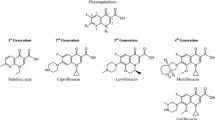Abstract
The ideal ophthalmic anti-infective exhibits broad-spectrum activity against grampositive, gram-negative, and atypical bacterial species. These pathogens can cause potentially blinding infections such as keratitis and endophthalmitis, both of which are associated with ophthalmic surgery or traumatic injury. These infections often require aggressive antibacterial therapy, preferably with newer generations of antibiotics. In this study, minimal inhibitory concentration (MIC) values for gatifloxacin and moxifloxacin were determined in vitro against bacterial strains that were isolated from suspected cases of bacterial keratitis and endophthalmitis. The ocular isolates included 7 gram-positive, 4 gram-negative, and 3 atypical bacterial species. Catifloxacin and moxifloxacin exhibited similar activity against 6 grampositive organisms:Staphylococcus epidermidis, Staphylococcus aureus, Streptococcus pneumoniae, Streptococcus pyogenes, Bacillus cereus, andEnterococcus faecalis. MIC90 values for the drugs against these isolates ranged from 0.08 mg/mL to 0.57 mg/mL and were comparable to previously published values against isolates from patients with systemic infections. The MIC90 for gatifloxacin againstStreptococcus viridans was 0.22 mg/mL compared with 0.73 mg/mL for moxifloxacin (P=.011). Among the gram-negative isolates, the mean MIC90 for gatifloxacin againstPseudomonas aeruginosa was 1.28 mg/mL compared with 2.60 mg/ mL for moxifloxacin (P=.023). MIC90 values for gatifloxacin againstKlebsiella pneumoniae andEnterobacter aerogenes were one fourth to one fifth the values for rnoxifloxacin. For the atypicals, the MIC90 values for gatifloxacin againstNocardia asteroides andMycobacterium chelonae were one fourth the corresponding values for rnoxifloxacin. Gatifloxacin demonstrated a broad spectrum of activity against several key ocular pathogens tested in this study and was at least as effective as moxifloxacin against these pathogens.
Similar content being viewed by others
References
Smith A, Pennefather PM, Kaye SB, Hart CA. Fluoroquinolones: place in ocular therapy.Drugs. 2001;61:747–761.
Blondeau JM. Gatifloxacin: a new fluoroquinolone.Expert Opin Investig Drugs. 2000;9:1877–1895.
Drlica K. Mechanism of fluoroquinolone action.Curr Opin Microbiol. 1999;2:504–508.
Higgins PG, Finit AC, Schmitz FJ. Fluoroquinolones: structure and target sites.Curr Drug Targets. 2003;4:181–190.
Fish DN, North DS. Gatifloxacin, an advanced 8-methoxy fluoroquinolone.Pharmacotherapy. 2001; 21:35–59.
Morden NE, Berke EM. Topical fluoroquinolones for eye and ear.Am Fam Physician. 2000;62: 1870–1876.
Fleiszig SM, Evans DJ. The pathogenesis of bacterial keratitis: studies with Pseudomonas aeruginosa.Clin Exp Optom. 2002;85:271–278.
McLeod SD. Treatment of bacterial keratitis.Compr Ophthalmol Upd. 2001; 217–224.
Sridhar MS, Gopinathan U, Garg P, Sharma S, Rao GN. OcularNocardia infections with special emphasis on the cornea.Surv Ophthalmol. 2001;45:361–378.
Karp CL, Tuli SS, Yoo SH, et al. Infectious keratitis after LASIK.Ophthalmology. 2003;110:503–510.
Callegan MC, Engelbert M, Parke DW 2nd, Jett BD, Gilmore MS. Bacterial endophthalmitis: epidemiology, therapeutics, and bacterium-host interactions.Clin Micmbiol Rev. 2002;15:111–124.
Irvine WD, Flynn HW Jr, Miller D, Pflugfelder SC. Endophthalmitis caused by Gram-negative organisms.Arch Ophthalmol. 1992;110:1450–1454.
Lomaestro BM. Therapeutic interchange of fluoroquinolones at a medical center.Am J Health Syst Pharm. 2001;58:904–907.
Everett SL, Kowalski RP, Karenchak LM, Landsittel D, Day R, Gordon YJ. An in vitro comparison of the susceptibilities of bacterial isolates from patients with conjunctivitis and blepharitis to newer and established topical antibiotics.Cornea. 1995;14:382–387.
Osato MS, Jensen HG, Trousdale MD, et al. The comparative in vitro activity of ofloxacin and selected ophthalmic antimicrobial agents against ocular bacterial isolates.Am J Ophthalmol. 1989;108:380–386.
Mather R, Karenchak LM, Romanowski EG, Kowalski RP. Fourth generation fluoroquinolones: new weapons in the arsenal of ophthalmic antibiotics.Am J Ophthalmol. 2002;133:463–466.
Donnenfeld ED, O’Brien TP, Solomon R, Perry HD, Speaker MG, Wittpenn J. Infectious keratitis after photorefractive keratectomy.Ophthalmology. 2003;110:743–747.
Robinson A, Kremer I, Avisar R, Gaton D, Savir H, Yassur Y. The combination of topical ceftazidime and aminoglycosides in the treatment of refractory pseudomonal keratitis.Graefes Arch Clin Exp Ophthalmol. 1999;237:177–180.
Author information
Authors and Affiliations
Rights and permissions
About this article
Cite this article
Callegan, M.C., Ramirez, R., Kane, S.T. et al. Antibacterial activity of the fourth-generation fluoroquinolones gatifloxacin and moxifloxacin against ocular pathogens. Adv Therapy 20, 246–252 (2003). https://doi.org/10.1007/BF02849853
Issue Date:
DOI: https://doi.org/10.1007/BF02849853




